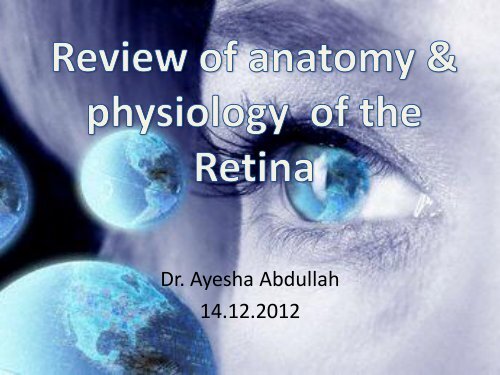Review of anatomy & physiology of the Retina
Review of anatomy & physiology of the Retina
Review of anatomy & physiology of the Retina
You also want an ePaper? Increase the reach of your titles
YUMPU automatically turns print PDFs into web optimized ePapers that Google loves.
Dr. Ayesha Abdullah<br />
14.12.2012
Learning outcomes<br />
By <strong>the</strong> end <strong>of</strong> this lecture <strong>the</strong> students would be<br />
able to;<br />
• Correlate <strong>the</strong> structural organization <strong>of</strong> <strong>the</strong><br />
retina with its functions and development.<br />
• Identify structural landmarks on retinal<br />
photographs.<br />
• Name <strong>the</strong> investigations commonly employed<br />
for <strong>the</strong> assessment <strong>of</strong> retinal disorders.
Some questions<br />
• How do we see<br />
• What are <strong>the</strong> similarities and differences between a camera<br />
and <strong>the</strong> eye<br />
• Name part <strong>of</strong> <strong>the</strong> nervous system that can be visualized<br />
without any invasive procedure<br />
• Why is <strong>the</strong> optic disc referred to as <strong>the</strong> blind spot<br />
• Have you noticed tiny bright moving dots when looking into<br />
<strong>the</strong> blue sky<br />
• If <strong>the</strong> photoreceptor had been anteriorly placed, what<br />
would have happened<br />
• How do we know its day/ night<br />
• How does <strong>the</strong> brain regulate circadian rhythms
Camera and <strong>the</strong> eye
• Unlike <strong>the</strong> image from a camera <strong>the</strong> resolution <strong>of</strong> <strong>the</strong> retinal image is not<br />
uniform.<br />
• Why<br />
• What is <strong>the</strong> result<br />
• There are about 100 times more photoreceptors than <strong>the</strong> Ganglion cells.<br />
• <strong>Retina</strong> compresses images as unlike <strong>the</strong> camera.
Anatomical landmarks <strong>of</strong> <strong>the</strong> retina
Optic disc<br />
Macula<br />
Fovea<br />
Foveola<br />
Normal dimensions<br />
Anatomical characteristics<br />
Place where <strong>the</strong> optic nerve fibers leave<br />
<strong>the</strong> retina. It is devoid <strong>of</strong> rods and cones<br />
hence <strong>the</strong> blind spot. Contains <strong>the</strong> central<br />
retinal artery and vein<br />
It is <strong>the</strong> area where <strong>the</strong> ganglion cells are<br />
two layered. Contains <strong>the</strong> xanthophyl<br />
pigment giving it <strong>the</strong> pigmented look.<br />
A depression in <strong>the</strong> inner retinal surface.<br />
It contains cones only.<br />
The inner nuclear layer and <strong>the</strong> ganglion<br />
cell layer is absent.<br />
Clinically Observable<br />
characteristics<br />
It’s a pale disc like<br />
structure with vessels<br />
emerging out <strong>of</strong> its center<br />
called <strong>the</strong> cup. Its about<br />
1.5 mm in size.<br />
It is about 5.5 mm in<br />
diameter (3.5 disc<br />
diameter/ 18 0 <strong>of</strong> visual<br />
angle). Roughly <strong>the</strong> area<br />
between <strong>the</strong> arterial<br />
arcades.<br />
A concave central retinal<br />
depression about <strong>the</strong> same<br />
size as <strong>the</strong> disc (1.5mm)<br />
Parafovea The thickest part <strong>of</strong> <strong>the</strong> retina Area surrounding <strong>the</strong> fovea
Histological structure <strong>of</strong> <strong>the</strong> retina
Development <strong>of</strong> <strong>the</strong> retina
Functions <strong>of</strong> <strong>the</strong> retina<br />
• Light perception<br />
• Brightness appreciation<br />
• Contrast sensitivity<br />
• Two point discrimination and appreciation <strong>of</strong><br />
details<br />
• Colour perception<br />
• Light and dark adaptation<br />
• Circadian rhythms & hormonal balance
Some important facts<br />
• There are about 150 million receptors and only 1 million optic nerve<br />
fibers, <strong>the</strong>re must be convergence and thus mixing <strong>of</strong> signals<br />
• The horizontal action <strong>of</strong> <strong>the</strong> horizontal and amacrine cells can allow<br />
one area <strong>of</strong> <strong>the</strong> retina to control ano<strong>the</strong>r (e.g., one stimulus<br />
inhibiting ano<strong>the</strong>r). This inhibition is key to <strong>the</strong> sum <strong>of</strong> messages<br />
sent to <strong>the</strong> higher centers <strong>of</strong> <strong>the</strong> brain.<br />
• The response <strong>of</strong> cones to various wavelengths <strong>of</strong> light is called <strong>the</strong>ir<br />
spectral sensitivity<br />
• There are blue, green, and red cones but more accurately short,<br />
medium, and long wavelength sensitive cone subgroupstrichromatic<br />
vision<br />
• The receptive field <strong>of</strong> a sensory neuron is a region <strong>of</strong> space in which<br />
<strong>the</strong> presence <strong>of</strong> a stimulus will alter <strong>the</strong> firing <strong>of</strong> that neuron<br />
• The receptive field <strong>of</strong> a Ganglion cell in <strong>the</strong> retina <strong>of</strong> <strong>the</strong> eye is<br />
composed <strong>of</strong> input from all <strong>of</strong> <strong>the</strong> photoreceptors which synapse<br />
with it, and a group <strong>of</strong> ganglion cells in turn forms <strong>the</strong> receptive<br />
field for a cell in <strong>the</strong> brain. This process is called convergence.
RPE<br />
vitreous
• Rod System<br />
– Achromatic<br />
– High convergence<br />
– High light sensitivity<br />
– Low visual acuity<br />
• Cone System<br />
– Chromatic<br />
– Low convergence<br />
– Low light sensitivity<br />
– High visual acuity<br />
Rods & Cones
Direction <strong>of</strong> visual<br />
impulse<br />
Direction <strong>of</strong> light
Investigations for retinal structural and<br />
functional assessment<br />
• Clinical assessment- Ophthalmoscopy
Ophthalmic investigations<br />
• Ultrasound –B & A scans<br />
• Ocular coherence tomography (OCT)<br />
• Angiography<br />
• Elctroretinogram<br />
• Elctro-oculogram
OCT
Angiography
Electroretinogram
Homework<br />
• What is <strong>the</strong> blood supply <strong>of</strong> <strong>the</strong> inner and<br />
outer retinal layers<br />
• What makes <strong>the</strong> inner and outer retinal blood<br />
barriers and what is <strong>the</strong>ir significance<br />
• E mail me at, <strong>the</strong> answer should not more<br />
than 04 lines.<br />
msqheartline@hotmail.com












